the complete guide to header bidding
Get a PDF copy of the guide using the form below, or scroll down to read the entire guide right on this page.
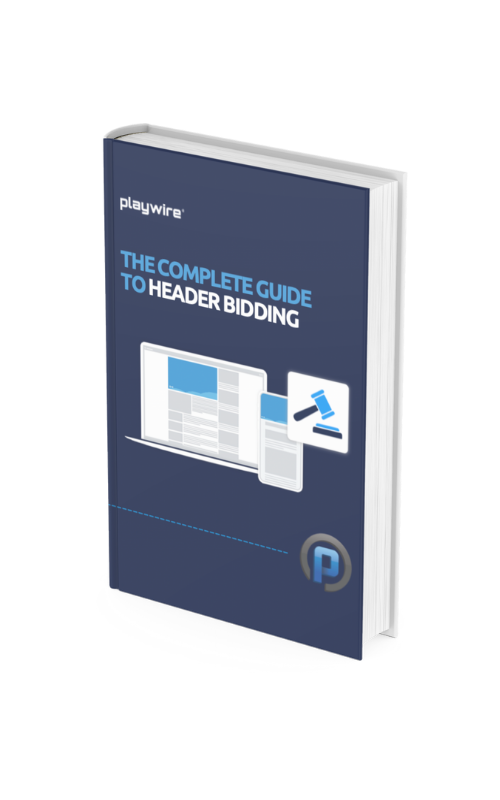
Don't Have Time To Read the Entire Guide Now?
We'll email you a downloadable PDF version of the guide and you can read later.
All of our content is generated by subject matter experts with years of ad tech experience and structured by writers and educators for ease of use and digestibility. Learn more about our rigorous interview, content production and review process here.
Built with the expertise of:
INTRODUCTION
Among innovations in advertising technology, programmatic advertising is something of a landmark in terms of advancements that sparked exponential ad revenue growth for publishers. But within programmatic advertising, a relatively recent innovation has pushed the ability for publishers to grow their revenue even further. It's called header bidding.
It's difficult to overstate the advertising revenue potential header bidding brings to the digital publishing world. It's also difficult to overstate how much time, effort, and knowledge goes into doing header bidding the right way.
We get it - publishers are pretty tired of hearing about all of the supposedly exciting, groundbreaking, game-changing ad tech innovations that make the rounds every few months. But hear us out on this one. If you do it right, header bidding really will work. And Playwire is here to help. We've put together this comprehensive guide to header bidding to help you understand everything you need to know to boost your ad revenue. Read on to learn more.
Playwire has worked for years to build the best-managed header bidding solution on the market. By combining several header bidding platforms and bringing in multiple demand sources on top of them, we offer the high demand you need to send your ad revenue skyrocketing. Contact us to learn more.
table of
contents
What is Header Bidding
Let's start with what header bidding is not. It is not a product, tool, software development kit (SDK), type of ad server, or anything like that. In its simplest form, header bidding is a concept - the concept of offering ad inventory on multiple ad exchanges at the exact same time.
What is Header Bidding?
Essentially, header bidding democratizes the auction process publishers and advertisers are already familiar with. All bidders get requests for bids simultaneously instead of having to wait for their turn in the lineup. This gives easy access to broader demand.
No More Waterfall
Before header bidding, the so-called "waterfall" approach dominated the programmatic advertising landscape. Basically, there would be a list of bidders. The request for bids on particular pieces of inventory would go to one bidder first and then to the next and so on until one of them bid an acceptable amount of money on the inventory.
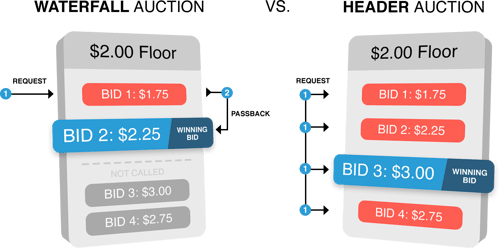
This created a problem. Publishers using this method miss out on potential revenue because they're at the mercy of the first bidder to make a bid. Someone further down the chain might have been willing to bid more, but the publisher would have never known.
Header bidding solves that problem. The waterfall bidding approach prioritizes the first bidder, but header bidding prioritizes the highest bidder. Header bidding is truly a publisher-first solution, aiming to truly maximize revenue for the publisher, by letting all demand partner bids compete. And the auction happens before an ad server is ever called.
While the waterfall method pings the ad server with an estimated cost per mille (CPM), header bidding completes the auction and either allows the publisher or header bidding partner pick the best one, or returns all the bids to the ad server, which will then pick the best in real-time and in conjunction with direct demand and similar line items.
Header Bidding for Publishers
For publishers, the primary benefit of header bidding is clear: increased revenue. In fact, many publishers using header bidding have increased their CPMs for premium inventory by up to 50%, according to Digiday.
But there's more to it than simply a jump in CPMs, although that's a pretty compelling benefit. Because header bidding allows publishers to branch out and use multiple supply-side platforms (SSPs), average yield can increase due to an increased fill rate and better allocation of impressions.
Beyond CPMS and yield, publishers who use header bidding have more control. They can pick and choose which bidders are allowed to participate in the simultaneous auctions of their inventory. In some cases, they can even prioritize certain agencies and advertisers in their auctions to keep demand source relationships going strong.
Header Bidding for Advertisers
Playwire always puts publishers first, but it would be unfair to discuss header bidding without at least mentioning some of the benefits this programmatic advertising method brings to advertisers.
The benefits of header bidding for advertisers come down to one word: fairness. Advertisers who participate in header bidding auctions get access to publishers' inventory that is more or less equal to the access that other advertisers get. That means advertisers don't have to keep playing second fiddle to big players on the biggest ad exchanges.
In that way, it really is like a real-life auction. You can see what's coming up for bidding, and you have the same shot at getting what you want as everyone else in the room. It's all about bidding the highest price for the premium inventory you just can't live without. The only thing missing is the rapid-fire shouting of an auctioneer.
The History of Header Bidding
Header bidding was born somewhere around 2014. Like many innovations in ad tech, the method had some early adopters who were quick to praise it as a revenue-boosting alternative to the waterfall method, but it would be a while before the waterfalls really started to run dry.
It wasn't until 2015 that the term "header bidding" actually became the term of art in the ad tech industry. The technology had a lot of early names, including holistic yield management, tagless integration, advance bidding, and pre-bidding. But then this 2015 article in the well-known trade publication AdExchanger set header bidding's name in stone.
That wasn't the only thing AdExchanger did with that article.
It also pointed out the ways in which header bidding was advantageous to publishers who had never been comfortable with the concept of funneling impressions through sales channels in sequential order based on their perceived worth. Put simply, the article proclaimed header bidding as the solution to the problems of the waterfall.
From there, the adoption of header bidding skyrocketed. By the end of 2017, 72% of websites based in the U.S. were using header bidding, according to eMarketer.
Of course, header bidding's history reaches further back in time than 2014. That's because it is rooted in programmatic advertising. To learn more about programmatic advertising, check out this comprehensive programmatic advertising guide.
Header Bidding Statistics
Publishers and advertisers are numbers people, so let’s have a look at the header bidding by the numbers:
According to Kevel, 84.1% of U.S.-based sites were doing header bidding at the end of Q2 of 2021.
At the beginning of 2019, an estimated 29% of header bidding impression share was being served up on mobile phone browsers and in apps, eMarketer reported.
Among publishers who adopted header bidding, 48% said in an eMarketer survey that one of the primary benefits they had seen was higher CPMs. Other benefits of header bidding named in the survey were increased yield (31%), fewer passbacks (23%) and less latency (11%).
As more publishers see the benefits of adopting header bidding into their ad sales strategies, numbers like these will only continue to grow.
How Header Bidding Works
The header bidding process begins with a few lines of code. This script is placed in the header of the publisher's website (hence the name). As soon as the webpage starts to load, that code is triggered and sends bid requests out to demand partners the publisher has signed up with.
This is when the auction begins. It can take place directly on the page (client-side header bidding) or on an off-site ad server (ad server-side header bidding). The request for bids triggered by the code that has just been executed in the publisher's header reaches multiple bidders, who then bid on the inventory.
These bids are based on various factors, such as cookie-derived information about the impression that is about to take place, the historical price of similar inventory, and the publisher. The winning bid - almost always the highest bid - gets the inventory. The information about the bid winner goes directly to the ad server the publisher uses. There, the winning bid competes with other demand sources, such as demand from direct ad buys.
The winner of that competition gets to serve their creative on the publisher's site. Now, take a breath. Look back at the last three paragraphs. All of that happened in an instant, while the site was loading for one particular user. The user who loaded the page (triggering the header script) is the one who will see the ad that just won an auction and a competition with various other demand sources.
Programmatic Advertising vs. Header Bidding
A lot of people talk about programmatic advertising and header bidding as they are two distinct pieces of advertising technology. That's not quite right. Saying that is like saying birds and crows are two different animals. Crows are a type of bird, and header bidding is a type of programmatic advertising.
In other words, programmatic advertising is an umbrella term. At its simplest, it's just an automated way to buy and sell ads. That's pretty broad and leaves a lot of room for specifics. Header bidding is one of them. So is the waterfall approach, although it's clearly less optimal than header bidding.
Header Bidding Platforms
Header bidding is a method - a concept or process. So, how do you take that abstract idea and put it into practice to increase your revenue as a publisher? With a header bidding platform. There are many header bidding platforms, but the major players include the following:
- Google's Exchange Bidding and Open Bidding
- Amazon's Unified Ad Marketplace (UAM) and Transparent Ad Marketplace (TAM)
- Prebid Server (Open-source framework & community)
We also like to throw Playwire into that mix. That's because our header bidding platform combines these and other header bidding platforms to get the highest amount of demand possible for publishers.
Let's take a look at the top header bidding platforms.
Exchange and Open Bidding vs. Header Bidding
If you've been doing your research about header bidding, you have probably stumbled across the terms "Exchange Bidding" or "Open Bidding." So what is the difference between Exchange Bidding and header bidding?
Also called Open Bidding, Exchange Bidding is simply Google's response to header bidding. It's a server-side header bidding-style approach to ad sales. Google Open Bidding is easier to "integrate" for publishers, which simply means it will work with any other Google tools you are already using in your ad sales strategy, such as Google Ad Manager 360.
While easier to set up from a technical integration standpoint, there is some lack of transparency that comes from running within a closed system. Incorporating Open Bidding along with other header bidding solutions will provide a publisher with maximum flexibility and potential for yield optimization. Luckily, if you're looking for help, Playwire incorporates all these platforms for you!
UAM and TAM vs. Header Bidding
Like Google, Amazon wanted to get in on the header bidding game, so it developed not one but two header bidding platforms: Unified Ad Marketplace (UAM) and Transparent Ad Marketplace (TAM). UAM is meant for smaller and mid-sized publishers, while TAM is meant for larger publishers.
This is the exact same situation as Google's Ad Manager or Open Bidding solution. UAM and TAM are header bidding platforms, so they are types of header bidding rather than distinct technologies. Both UAM and TAM are server-side header bidding solutions. And both include a dashboard in which publishers manage their auctions and add their own demand if they choose to do so.
Prebid vs. Header Bidding
Prebid is a free, open-source header bidding platform. AppNexus created Prebid in the early days of header bidding with the goal of being transparent and democratic, and they achieved that goal in many ways. This header bidding solution began as a client-side platform but has since brought in server-side and mobile integrations.
Prebid is the largest header bidding platform, and it has a large community surrounding it. However, it is very much the do-it-yourself side of header bidding. For publishers with large ad ops teams and lots of time to invest, it can work well, but without those assets, you may find yourself struggling to properly set up header bidding on your website or in your app.
Playwire vs. Header Bidding
When discussing header bidding platforms like Open Bidding, UAM, TAM, and Prebid, it's important to remember that working with one header bidding platform can still limit your revenue because different platforms have access to different areas of demand. That's why Playwire integrates many of the top header bidding platforms into our own platform.
Make no mistake - those platforms include all of those we have discussed above. In fact, we're a Google-certified publisher and put a lot of effort into maintaining strong relationships with all of the top header bidding platforms to ensure that our publishers have access to the broadest inventory demand on the market. We facilitate simultaneous auctions via each of the header bidding platforms, meaning we take their ability to increase demand and multiply it.
How to Implement Header Bidding
At this stage, you understand that the first step in implementing header bidding is choosing the header bidding platform you want to trust with your ad inventory. But that is not the only choice you are going to have to make. You will have to choose between client-side header bidding and server-side header bidding. Each option has different requirements and steps to set up on your website or app. We explore client-side and server-side header bidding implementation below.
Client Side Header Bidding
In the beginning, all header bidding was client side header bidding. Here's how it works: you have a small piece of Javascript code in the header of your site. This code is ultimately responsible for calling and facilitating the auctions of your ad inventory.
The code has a lot of different configurations, each of which can determine which bidders to call into an auction, which ad units to auction, which branders to use, and more. Each bidder, the script calls are slotted into a port, and the number of ports you have available in client-side header bidding is limited.
That creates a problem. You are limited in the number of bidders you can call. This limitation exists because, if you have to call too many ports from your site's header, you will add latency to the user experience of your site.
Latency refers to the delay while data moves through an ad network connection; this appears to the user as a delay between the time they accessed the webpage and the time the ad and/or content appeared to them. Too many ports will take away important resources from your site, meaning it will load more slowly. Having latency introduced due to client-side header bidding can be detrimental to the performance of your website overall and can give client-side header bidding a bad reputation.
Server Side Header Bidding
Server side header bidding came onto the scene after client-side header bidding. It was meant to overcome some of the limitations of the client-side model, such as the fact that the client-side approach taxes a website's resources pretty heavily.
And it did solve that. Basically, the mechanics of server-side header bidding are identical to the mechanics of client-side header bidding. There's just one major difference: the heavy lifting of sending out requests for bids and handling the mechanics of the auction is taken off of the publisher's website and placed onto an ad server. You still have code in your header, but that code pings the server and tells it to call in the bidders and hold the auction. Then, the ad server sends the information from the auction to an ad server, and the rest of the header bidding process takes place.
Server-side header bidding adds speed to the process because the work is done on a dedicated server that has a lot more power than a typical website. It also allows you to call in more bidders, which means more demand for your inventory. For these reasons, most of the newer header bidding platforms are server-side platforms.
These are big upsides, but this method does come with some drawbacks. Namely, you can lose a little on the user syncing and cookie matching fronts, meaning impressions aren't as targeted to individual users. That, of course, can reduce ad impression value. However, many of the major header bidding platforms have found their way around that issue, but it is still one of the initial drawbacks of server-side header bidding.
Header Bidding Wrapper
A header bidding wrapper is a piece of JavaScript code that initiates the calls for header bidding auctions. It sends out the signals to bidders that an auction is happening, and it contains the rules that facilitate the programmatic auctions that take place either in your website's header or on a separate ad server.
Header bidding wrappers are also called header bidding containers or frameworks, but they all do the same thing: They facilitate the header bidding auctions that bring revenue to publishers.
While header bidding wrappers aren't actually essential to doing header bidding, they are virtually essential. That's because, without a wrapper, you would have to handle and integrate individual pieces of code in your website's header for every single bidder to place a bid request on your inventory.
Understanding Video Header Bidding
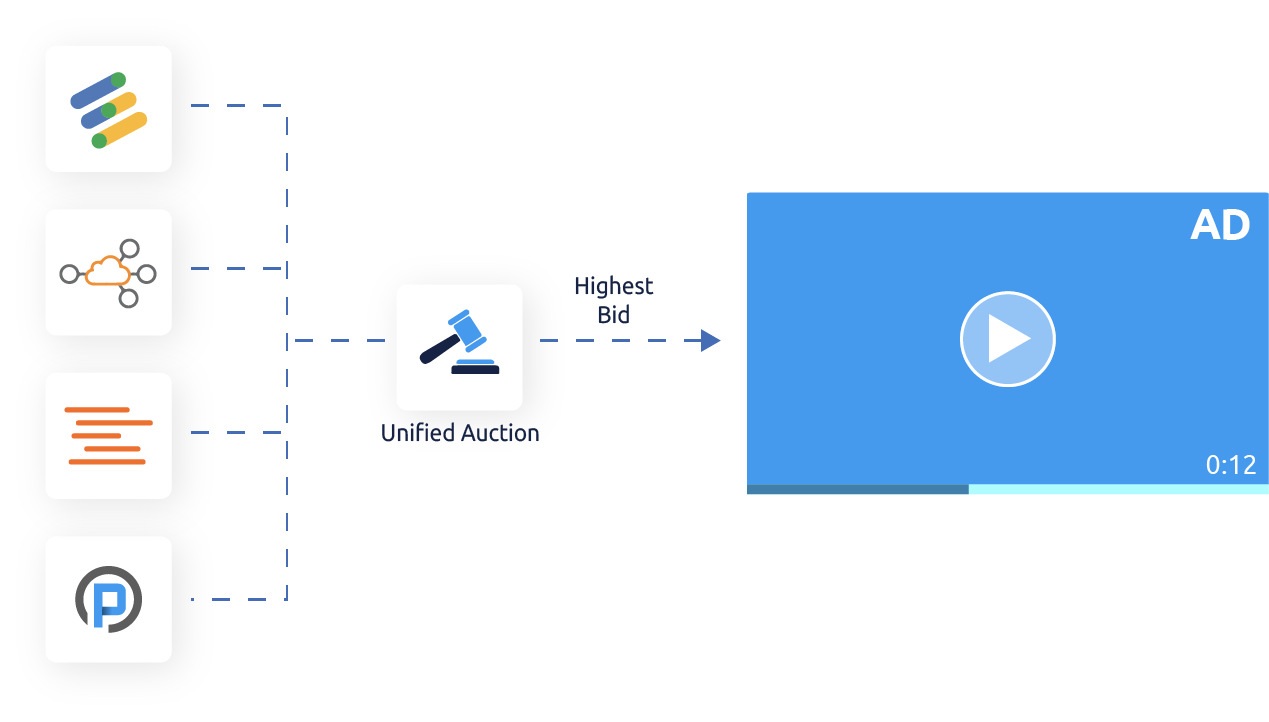
Up to this point, we have been discussing header bidding for classic display ads like banners. But what about video? Video is, after all, the latest and greatest in digital advertising. Shouldn't publishers be able to sell video inventory via header bidding?
They should. And they can. Video header bidding is much newer than display header bidding. It really only gained traction around 2019, while display has been around since 2015 or earlier. Playwire was one of the first ad industry players to implement video header bidding at scale. It works almost exactly like display header bidding.
It's true - you have a piece of code that kicks off the call for bids, triggers the auction, and gets the results back from the ad server. There's just one real difference: instead of the script being nestled into your header, it's embedded in a video player - such as Playwire's Trendi video player - where it triggers the auction to serve a video ad to a user who is about to watch a video on your site.
Because the video header bidding process is so similar to the display header bidding process, the benefits of the two processes are largely the same. You still get broader access to advertiser demand, and you still get higher average CPMs and yield.
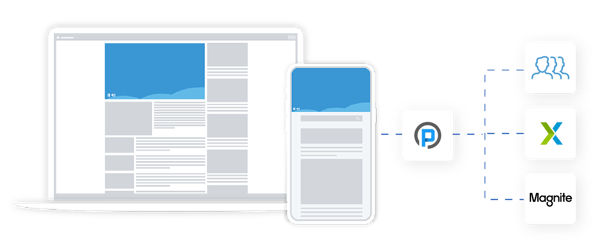
In-App Header Bidding: What You Need to Know
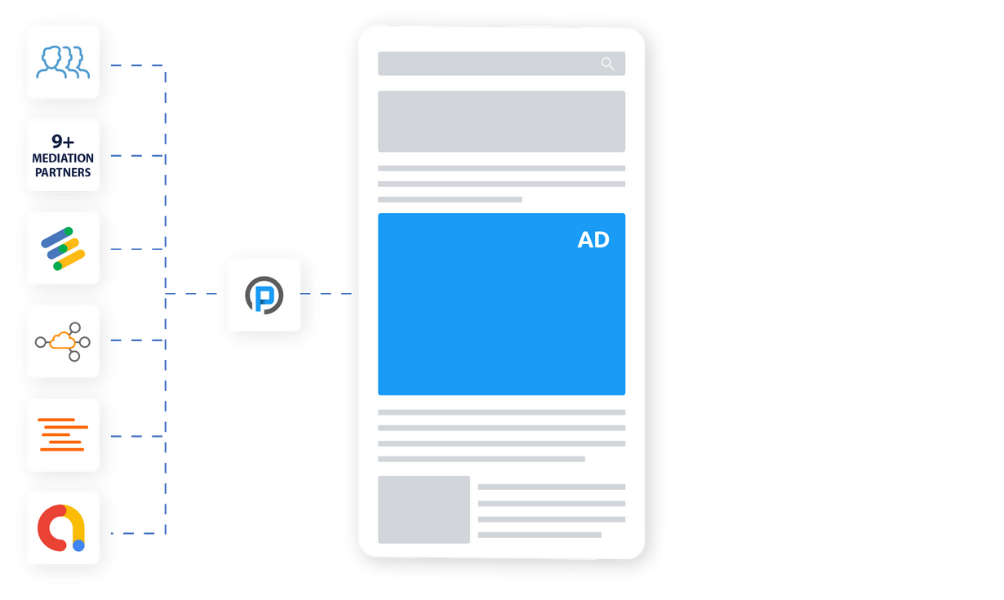
There may not be an app for header bidding, but there's certainly header bidding for apps. In-app header bidding is similar to header bidding for display and video. A user loads the app or the place within the app that is meant to serve an ad, a request for bids is sent from the app to a server, an auction takes place and the highest bidder or prioritized direct ad is served to the user in an instant.
You have just one major difference to keep in mind: unlike website headers and video players, the app doesn't have any client-side code embedded in it to call the server. Instead, a software development kit (SDK) that supports your chosen header bidding platform calls the server. Otherwise, however, the mechanics are all the same.
Playwire's mobile header bidding SDK is like an SDK of SDKs. In other words, we pull in multiple SDKs for the most powerful in-app header bidding platforms to generate the most in-app header bidding demand possible.
What is a Header Bidding Wrapper?
Header bidding wrapper, container, framework - these terms all refer to the same thing. A wrapper is a Javascript tag that essentially acts like a bucket that contains all the code that manages your bidders and programmatic auctions. It's in the header of your site.
Your header bidding wrapper will call multiple demand partners for bids when a user visits your site. It will also contain the rules for your inventory auction. If the header bidding process takes too long, it will trigger a timeout response to ensure the user isn't left waiting for your ads or content to load.
A wrapper isn't absolutely required for you to implement header bidding, but it certainly helps to streamline the process. Once you've placed the wrapper on your site and tested it to make sure it works, you can make changes to bidders and auction rules in a separate interface, as opposed to having to go into the code of your site and make the change manually every time.
Best Practices for Header Bidding
Header bidding has been a revenue game-changer for countless web publishers. It's fostering sustained growth throughout the digital publishing landscape. But that doesn't mean it's easy.
As much as there's a right way to do header bidding, there's a wrong way, too. And lots of publishers are doing it the wrong way, reducing or even eliminating the revenue-boosting benefits of this ad sales method.
Playwire is here to help you do it right. The first step is keeping these header bidding best practices in mind.
Keep Latency in Mind
If you are doing pure client-side header bidding implementation, latency should be at the forefront of your concerns. That's because slow content and ad load times are a serious and common issue in client-side header bidding.
How do you reduce latency? By making sure you limit the number of bid adapters - the pieces of code that call individual bidders - in your wrapper. Generally, you will start to see latency become an issue on your site after around seven bid adapters.
It seems simple - just keep your total number of bidders below seven, and you're golden. But what if you want more demand than that? What if you have 30 bidders you want to work with? You shouldn't have to tell 23 of them to hit the road just because you're worried about latency. Fortunately, you don't have to.
There are two key ways to mitigate this issue. The first is opting for a server-side header bidding solution. A dedicated server can handle a lot more bidders at once than your site alone can. The second solution is working with a header bidding management partner like Playwire. Header bidding professionals can tweak your setup to ensure latency is a distant memory and you are able to work with as many bidders as you want.
Get the Setup Right from the Start
Header bidding gets you access to more demand. It shouldn't be creating a bunch of confusion and stress in the process, though. But this is what happens when you don't properly configure header bidding on your site or app.
When you're first diving in, it's normal to be excited to get the code on your site and see what it does for your revenue. If that comes at the expense of testing and making sure you've got every line of code exactly right, however, you're going to run into trouble later on. The complex and delicate header bidding process will break, and you will miss revenue, fail to deliver the impressions you're promising, and waste a lot of time trying to fix the issue you could have avoided in the first place.
At the very beginning of the process, think about your end goals, resources, capabilities, available time, and revenue. How does header bidding - and the taxing implementation process - fit into that framework? If you're flying by the seat of your pants and figuring out the setup as you go, be prepared to do a lot of troubleshooting. Alternatively, consider working with a professional team to get it set up right the first time.
Manage Your Bid Adapters Wisely
Over time, you will want to add and remove bidders in your header bidding portfolio. Each bid adapter you add to or remove from your header bidding wrapper is a chunk of code that connects your wrapper to SSP servers. To manage your header bidding setup well, you will need to fully understand each part of that code to be certain it won't break any other part of the process. That means testing it thoroughly before bringing it to your live site.
Alternatively, you can take advantage of resources like Playwire's header bidding setup. Our platform has already done the legwork of vetting, integrating, and testing an enormous number of bidders.
Make Sure You’re Speaking the Right (Coding) Languages
It's a frustrating fact of life that header bidding is code-heavy. It's all about the code in your header or video player and how it interacts with the various servers and bidders along the ad production line. And sometimes, the code used on the client-side and server-side will be in completely different languages.
If you've ever visited a country where you didn't speak the language, you're aware of the trouble this can cause. Your site and the server need to be able to communicate clearly. If they're speaking different languages, they need a translator. In the header bidding world, an expert developer is that translator. Even if you're confident that you or someone on your team will be able to work on your site, you may need different development resources to get the job done on the other end of the process.
Set Your Price Floors Properly
If you're at all familiar with programmatic advertising, you're familiar with the concept of price floors. A price floor is just a baseline CPM rate that you aren't willing to go under. That means none of your ad partners can serve ads on your site that are below this rate.
Price floors are a big deal in header bidding. Without the proper price floor setup, you immediately enter a race to the bottom for the cheapest CPMs. So, be sure you have configured your price floors in a way that's comfortable for you.
Keep in mind, too, that the price floors for video and display are likely to be different, and without setting them up individually, you risk the two types of inventory starting to cannibalize themselves.
The bidders who participate in your auctions are likely to have tools that help them understand historical pricing and their expected auction win rate based on demand, their CPMs, and even factors as minute as the time of day. This is the type of battle that you don't want to come to unarmed, so take some time to review the available tools that can help you understand historical pricing for inventory like yours. Playwire's Revenue Intelligence tools are a great example.
Take Header Bidding to the Next Level with Playwire
If you’re not using header bidding, you’re missing out on revenue. It’s as simple as that. And even if you are using header bidding, there’s a good chance you’re not doing it in an optimal way, again leaving revenue on the table.
How do you fix that? By working with a header bidding management partner like Playwire. Our ad ops and yield ops teams have decades of combined experience working inside all of the major header bidding tools on the market. That way, if Google makes a change to Open Bidding or Amazon changes TAM, you don’t have to go scrambling to keep your revenue intact. You can keep doing what you’re doing while we make the changes necessary to keep your revenue at maximum strength.
Ready to take header bidding to the next level? Get in touch with us to discuss your way forward. Contact us online today.
Related Content

You can visit the complete Header Bidding Resource Center or dive deeper into any of these related articles:
- What Is Header Bidding and Why Should Publishers Be Doing It?
- What is a Header Bidding Wrapper?
- Programmatic vs. Header Bidding
- Video Header Bidding: What Publishers Need to Know
- How In-App Header Bidding Works
- Exchange Bidding vs Header Bidding
- 6 Biggest Benefits of Header Bidding
- How a Header Bidding Integration Works
- Header Bidding for Publishers: Why You Need It
- Playwire vs. DIY Header Bidding Solutions
- Intro to Header Bidding Online Course
- Intro to Video Header Bidding Online Course
-
Header Bidding Solutions: Maximizing Revenue from Header Bidding
Amplify
Your Ad Revenue
Accelerate your business and uncomplicate your ad tech stack, because you deserve a partner and a platform that demands more for you.


